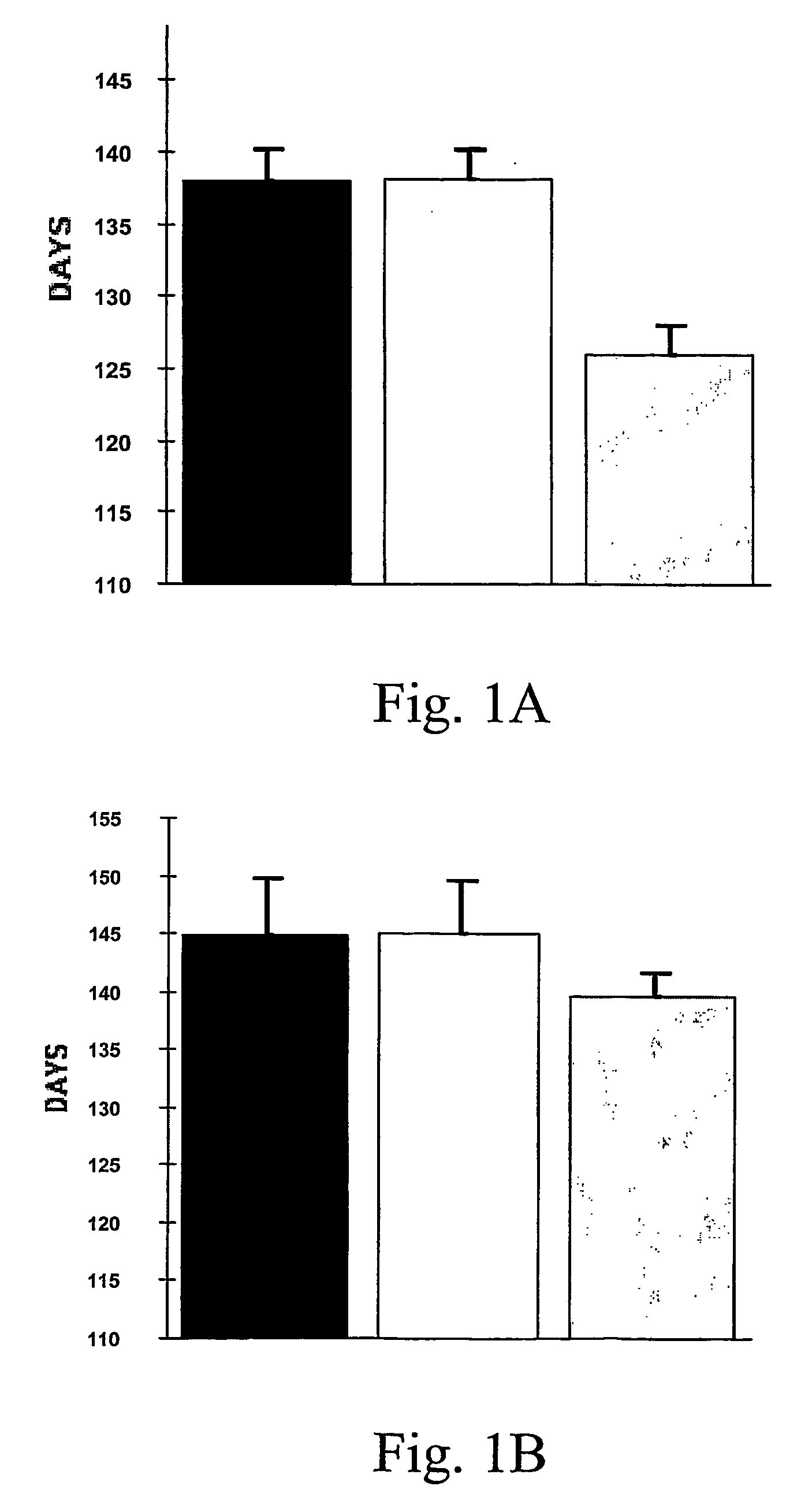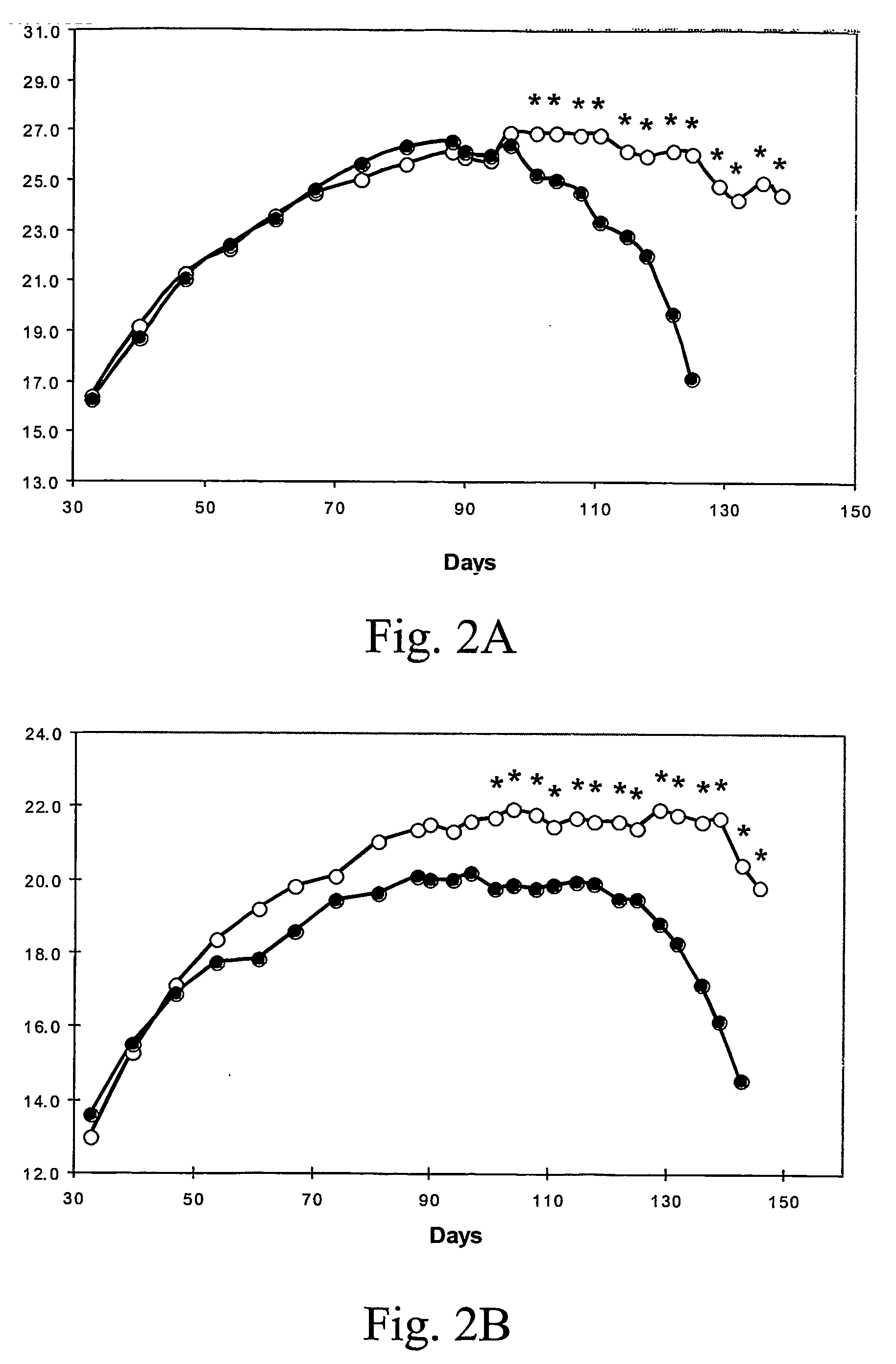Use of gingko biloba extracts to promote neuroprotection and reduce weight loss
a technology of gingko biloba and extract, which is applied in the field of extracts of gingko biloba, can solve the problems of increasing the risk of neurotoxicity, affecting the survival of patients, and generating toxic reaction products, so as to reduce the extent of weight loss, delay or decrease the development of clinical and neuropathologic symptoms, and increase the lifespan
- Summary
- Abstract
- Description
- Claims
- Application Information
AI Technical Summary
Benefits of technology
Problems solved by technology
Method used
Image
Examples
example 1
[0059] Effect of Egb761 Administration on the Survival of G93A Mutant Transgenic Mice
[0060] Transgenic mice with the G93A human SOD1 mutation (G1H / +) were obtained from Jackson Laboratories (Bar Harbor, ME). Male G1H / + mice were bred with female mice on the B6SJL background strain and the offspring were genotyped by PCR of DNA obtained from tail tissue. Twenty male and female mice from each feeding paradigm were fed with either an unsupplemented diet or a diet supplemented with 0.022% or 0.045% EGb761 (Beaufour Ipsen Pharma, Paris, France) started at 21 days of age. This corresponds to 200 mg / kg / d and 400 mg / kg / d, respectively. Mice were weighed weekly starting at 23 days of age and twice weekly starting at 90 days of age.
[0061] The oral administration of EGb761 resulted in a significant increase in survival in male transgenic G93A mice supplemented with either 0.022% (137.9±2.3 d) or 0.045% (138.2±1.9 d) Egb761 as compared to unsupplemented littermate G93A male mice (126.0±2.0 d)...
example 2
[0063] Effect of Egb761 Administration on the Age-Dependent Loss of Bode Weight in G93A Mutant Transgenic Mice In both male and female transgenic G93A mice, oral administration of EGb761 significantly delayed an age-dependent loss of body weight. The effects of oral administration of EGb761 on body weight in G93A transgenic mice are shown in FIGS. 2A-2B. Both EGb761 regimens (0.022% and 0.045%) resulted significant improvements of body weight as compared to unsupplemented G93A mice. While body weight measurements were recorded throughout the temporal sequence of the experiment in the 0.022% EGb761 treated G93A mice, significance was only found from 101 days in both male (FIG. 2A) and female (FIG. 2B) mice, as compared to unsupplemented G93A mice. Unsupplemented mice are depicted in dark circles in FIGS. 2A-2B (*p<0.05).
example 3
[0064] Effect of Egb761 Administration on Muscle Strength in G93A Mutant Transgenic Mice
[0065] Performance on rotarod as an index of muscle strength was assessed weekly starting at 23 days of age and twice weekly starting at 90 days of age. Mice were given two days to become acquainted with the rotarod apparatus (Columbus Instruments, Columbus, Ohio). The rotarod was maintained at 10 rpm. Each mouse was given three trials at 60 seconds each for a maximum of 180 seconds at each time point. The length of time at which the mouse fell off the rotating rod was used as the measure of competency on this task. Mice were tested until they were unable to perform the task (120 days and 130 days for male and female mice, respectively). Mice were euthanized when they were no longer able to right themselves within 30 seconds of being placed on their sides. This time point was used as the time of death.
[0066] The effects of oral administration of 0.022% and 0.045% EGb761 on rotarod performance b...
PUM
 Login to View More
Login to View More Abstract
Description
Claims
Application Information
 Login to View More
Login to View More - R&D
- Intellectual Property
- Life Sciences
- Materials
- Tech Scout
- Unparalleled Data Quality
- Higher Quality Content
- 60% Fewer Hallucinations
Browse by: Latest US Patents, China's latest patents, Technical Efficacy Thesaurus, Application Domain, Technology Topic, Popular Technical Reports.
© 2025 PatSnap. All rights reserved.Legal|Privacy policy|Modern Slavery Act Transparency Statement|Sitemap|About US| Contact US: help@patsnap.com



